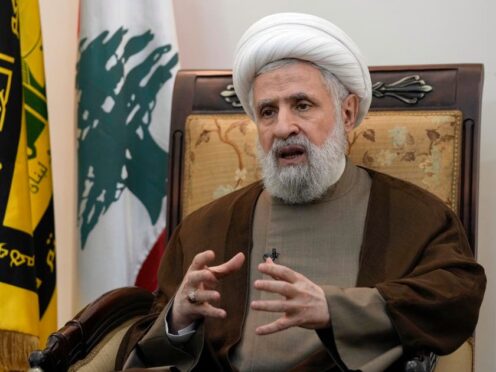
The deputy leader of the Lebanese militant group Hezbollah has said the only sure path to a ceasefire on the Lebanon-Israel border is a full ceasefire in Gaza.
“If there is a ceasefire in Gaza, we will stop without any discussion,” Hezbollah’s deputy leader, Sheikh Naim Kassem, said in an interview with The Associated Press at the group’s political office in Beirut’s southern suburbs.
Hezbollah’s participation in the Israel-Hamas war has been as a “support front” for its ally, Hamas, Sheikh Kassem said, and “if the war stops, this military support will no longer exist”.
But, he said, if Israel scales back its military operations without a formal ceasefire agreement and full withdrawal from Gaza, the implications for the Lebanon-Israel border conflict are less clear.
“If what happens in Gaza is a mix between ceasefire and no ceasefire, war and no war, we can’t answer (how we would react) now, because we don’t know its shape, its results, its impacts,” Sheikh Kassem said during a 40-minute interview.
In recent weeks, with Gaza ceasefire talks faltering, fears have increased of an escalation on the Lebanon-Israel front.
Hezbollah has traded near-daily strikes with Israeli forces along their border over the past nine months. The low-level conflict between Israel and Hezbollah has displaced tens of thousands on both sides of the Israel-Lebanon border.
In northern Israel, 16 soldiers and 11 civilians have been killed; in Lebanon, more than 450 people — mostly fighters but also dozens of civilians — have been killed.
Months of internationally brokered Gaza ceasefire talks have repeatedly failed. Hamas has demanded an end to the war, and not just a pause in fighting, while Israeli Prime Minister Benjamin Netanyahu has refused to make such a commitment until Israel realises its goals of destroying Hamas’s military and governing capabilities and brings home the roughly 120 hostages still held by Hamas.
Last month, the Israeli army said it has “approved and validated” plans for an offensive in Lebanon if no diplomatic solution is reached to the ongoing clashes. Any decision to launch such an operation would have to come from the country’s political leadership.

Some Israeli officials have said they are seeking a diplomatic solution to the standoff and hope to avoid war. At the same time, they have warned that the scenes of destruction seen in Gaza will be repeated in Lebanon if war breaks out.
Hezbollah, meanwhile, is far more powerful than Hamas and believed to have a vast arsenal of rockets and missiles capable of striking anywhere in Israel.
Sheikh Kassem said he does not believe that Israel has the ability or has made a decision to launch a war at present. He warned that even if Israel intends to launch a limited operation in Lebanon that stops short of a full-scale war, it should not expect the fighting to remain limited.
“Israel can decide what it wants: limited war, total war, partial war,” he said.
“But it should expect that our response and our resistance will not be within a ceiling and rules of engagement set by Israel … If Israel wages the war, it means it doesn’t control its extent or who enters into it.”
The latter was an apparent reference to Hezbollah’s allies in the Iran-backed so-called “axis of resistance” in the region.
Armed groups in Iraq, Syria, Yemen and elsewhere – and, potentially, Iran itself – could enter the fray in the event of a full-scale war in Lebanon, which might also pull in Israel’s strongest ally, the United States.
US and European diplomats have made a circuit between Lebanon and Israel for months in an attempt to ward off a wider conflict.
Sheikh Kassem said he met on Saturday Germany’s deputy chief of intelligence, Ole Dieh, in Beirut. US officials do not meet directly with Hezbollah because Washington has designated it a terrorist group, but they regularly send messages via intermediaries.
Sheikh Kassem said White House envoy Amos Hochstein had recently requested through intermediaries that Hezbollah apply pressure on Hamas to accept a ceasefire and hostage-exchange proposal put forward by President Joe Biden. He said Hezbollah had rejected the request.
“Hamas is the one that makes its decisions and whoever wants to ask for something should talk to it directly,” he said.
Sheikh Kassem criticised US efforts to find a resolution to the war in Gaza, saying it has backed Israel’s plans to end Hamas’s presence in Gaza. A constructive deal, he said, would aim to end the war, get Israel to withdraw from Gaza, and ensure the release of hostages.
Once a ceasefire is reached, then a political track can determine the arrangements inside Gaza and on the front with Lebanon, he added.

Enjoy the convenience of having The Sunday Post delivered as a digital ePaper straight to your smartphone, tablet or computer.
Subscribe for only £5.49 a month and enjoy all the benefits of the printed paper as a digital replica.
Subscribe